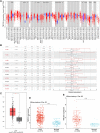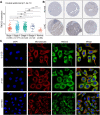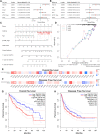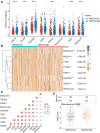Transmembrane and coiled-coil domains 3 is a diagnostic biomarker for predicting immune checkpoint blockade efficacy in hepatocellular carcinoma
- PMID: 36246598
- PMCID: PMC9556949
- DOI: 10.3389/fgene.2022.1006357
Transmembrane and coiled-coil domains 3 is a diagnostic biomarker for predicting immune checkpoint blockade efficacy in hepatocellular carcinoma
Erratum in
-
Corrigendum: Transmembrane and coiled-coil domains 3 is a diagnostic biomarker for predicting immune checkpoint blockade efficacy in hepatocellular carcinoma.Front Genet. 2023 Jan 16;13:1117731. doi: 10.3389/fgene.2022.1117731. eCollection 2022. Front Genet. 2023. PMID: 36726717 Free PMC article.
Abstract
Liver hepatocellular carcinoma (LIHC) is a malignancy with a high mortality and morbidity rate worldwide. However, the pathogenesis of LIHC has still not been thoroughly studied. Transmembrane and coiled-coil domains 3 (TMCO3) encodes a monovalent cation, a member of the proton transducer 2 (CPA2) family of transporter proteins. In the present study, TMCO3 expression and its relationship with cancer prognosis, as well as its immunological role in LIHC were studied by bioinformatic analysis. We found the significant overexpression of TMCO3 in LIHC in the TCGA, HCCDB, and GEO databases. In LIHC patients, high TMCO3 expression was related to poorer overall survival (OS) and TMCO3 had good predictive accuracy for prognosis. Moreover, TMCO3 was linked to the infiltrates of certain immune cells in LIHC. The correlation of TMCO3 with immune checkpoints was also revealed. Moreover, patients with LIHC with low TMCO3 expression showed a better response to immune checkpoint blockade (ICB) than those with LIHC with high TMCO3 expression. GO and KEGG enrichment analyses indicated that TMCO3 was probably involved in the microtubule cytoskeleton organization involved in mitosis, small GTPase mediated signal transduction, and TGF-β pathway. In conclusion, TMCO3 may be a potential biomarker for LIHC prognosis and immunotherapy.
Keywords: ICB; LIHC; TMCO3; diagnostics; immune infiltrates.
Copyright © 2022 Hu, Zhu, Feng, Wang, Ye and Xiong.
Conflict of interest statement
The authors declare that the research was conducted in the absence of any commercial or financial relationships that could be construed as a potential conflict of interest.
Figures







Similar articles
-
Corrigendum: Transmembrane and coiled-coil domains 3 is a diagnostic biomarker for predicting immune checkpoint blockade efficacy in hepatocellular carcinoma.Front Genet. 2023 Jan 16;13:1117731. doi: 10.3389/fgene.2022.1117731. eCollection 2022. Front Genet. 2023. PMID: 36726717 Free PMC article.
-
Upregulation of TMCO3 Promoting Tumor Progression and Contributing to the Poor Prognosis of Hepatocellular Carcinoma.J Clin Transl Hepatol. 2022 Oct 28;10(5):913-924. doi: 10.14218/JCTH.2021.00346. Epub 2022 Jan 10. J Clin Transl Hepatol. 2022. PMID: 36304514 Free PMC article.
-
Prognostic Value and Immunological Role of KIFC1 in Hepatocellular Carcinoma.Front Mol Biosci. 2022 Jan 17;8:799651. doi: 10.3389/fmolb.2021.799651. eCollection 2021. Front Mol Biosci. 2022. PMID: 35111813 Free PMC article.
-
CPNE1 is a potential prognostic biomarker, associated with immune infiltrates and promotes progression of hepatocellular carcinoma.Cancer Cell Int. 2022 Feb 9;22(1):67. doi: 10.1186/s12935-022-02485-2. Cancer Cell Int. 2022. PMID: 35139863 Free PMC article.
-
Ferroptosis regulator SLC7A11 is a prognostic marker and correlated with PD-L1 and immune cell infiltration in liver hepatocellular carcinoma.Front Mol Biosci. 2022 Oct 4;9:1012505. doi: 10.3389/fmolb.2022.1012505. eCollection 2022. Front Mol Biosci. 2022. PMID: 36267158 Free PMC article.
Cited by
-
m6A-Mediated TMCO3 Promotes Hepatocellular Carcinoma Progression by Facilitating the Membrane Translocation and Activation of AKT.Adv Sci (Weinh). 2025 Jul;12(27):e2504187. doi: 10.1002/advs.202504187. Epub 2025 Apr 26. Adv Sci (Weinh). 2025. PMID: 40285646 Free PMC article.
-
Predictive and Prognostic Relevance of Tumor-Infiltrating Immune Cells: Tailoring Personalized Treatments against Different Cancer Types.Cancers (Basel). 2024 Apr 23;16(9):1626. doi: 10.3390/cancers16091626. Cancers (Basel). 2024. PMID: 38730579 Free PMC article. Review.
-
Platelet-derived circRNAs signature in patients with gastroenteropancreatic neuroendocrine tumors.J Transl Med. 2023 Aug 16;21(1):548. doi: 10.1186/s12967-023-04417-8. J Transl Med. 2023. PMID: 37587471 Free PMC article.
References
LinkOut - more resources
Full Text Sources

